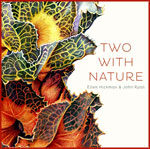
Two with Nature by Ellen Hickman and John Ryan
Fremantle Press, 2012
As a book quite different to what is usually seen in the poetry sphere, Two with Nature, Fremantle Press’s book combining the poetry of John Ryan with the botanical illustrations of Ellen Hickman, contains some interesting possibilities and contradictions. In his introduction Ryan notes how ‘the term ‘botanical poetry’ might seem an unusual juxtaposition of two quite different practices – science and poetry’ and it is here that the importance of the ‘with’ in the title can be seen as Ryan and Hickman’s aim appears to be with nature through a combination of scientifically accurate illustration and poetry.
An interesting conundrum brought up by such a project is how the founding principle of discovery botany, with its focus on the herbarium specimen as the prime example of a species, is both present and critiqued in Two with Nature. Indeed while Hickman’s illustration are for the most part completely de-contextualised and thus appear to inscribe the idea of the ideal specimen, as is the norm in botanical illustration, Ryan’s poems appear to be an attempt re-contextualise these images through poetry, with the discourses of history, Indigenous knowledges, ecocriticism and personal reflection. In his attempt to emplace these plants, Ryan’s use of time and walking in the poetry is crucial. As he reflects in his bio that taking long walking trips has been a long habit of his, Ryan describes how ‘I kept a poetry journal; the walking became part of the writing – I still find that I write best to a bipedal rhythm, even if I am not physically moving.’ Indeed, this bipedal rhythm and the idea of movement in time appears across many of the poems, including ‘Tree Top Walk’ in which:
these forests are seldom lines or strict geometries, but tufts & leans, high cumulus-shaped canopies & cavities cleft in pachydermal trunks, & burls wart-like & chelonian above buttresses spidery
Here the use of ampersand creates a point of return and of accumulation. The different views of the forest are placed so the reader moves through them as if on a walk. However, the ampersands also come to be a point of return even as they open out, suggesting a kind of circular movement in which one is more concerned about exploration than a destination. Such a layering depicts the forest as a space that defies a singular ‘essential’ definition in its ‘tufts & leans’, a suggestion of almost casual contrariness that disrupts the ‘lines or strict geometries’ scientific discourse may bring in the first line.
Ryan also attempts to place the plants he discusses physically, something absent in Hickman’s illustrations. The third stanza of ‘Inside a Jarrah Tree, A Black Tunnel Reaching Skyward’ describes how:
outside, the grass trees don verdant headdresses over the charred land, and kino sap stamps red insignias along marri trunks;
In situating the jarrah tree within a specific ecosystem Ryan attempts to rewrite discovery botanic discourses that, through their preservation of specimens, take as their primary instance the sample as object. Here the jarrah tree is not only part of a system, it is part of a specific physical place within that system. Ryan also places people, most frequently himself, within these ecologies, something discovery botanic science does not often foreground. In the above poem Ryan poses multiple questions to the reader, finally asking:
have you ever breathed inside a tree to feel the cool glance of air where once a molten river ran, seeing the outside from within? witchetty grubs or kookaburras might, clawing skyward toward a portal of light but I would not stand here forever.
Here Ryan appears to be gently questioning the reader until his last comment, in which both become the subject of an unsettling gaze, and the very idea of a presence within, and what that could mean, are questioned.
As a very specific book, Two with Nature has an interesting relationship to both scientific and poetic discourse. In his creation of botanically accurate poems to accompany Hickman’s illustrations Ryan attempts to bring a sense of multiple discourses and imagination to this science. He also appears to be rewriting certain principles that can underlie discovery botany, situating the decontextualized illustrations and representing the movement, ecological surroundings and human presence that has always been a part of this science, even if this has often been denied. How well this ecocritical project succeeds remains up to the reader, however, as while the book claims to marry poetry with botanical illustration, Hickman’s drawings consistently outnumber Ryan’s poems. Further, the two are presented as separate to each other, with Ryan’s poems never physically interacting with Hickman’s illustrations on the page, save for a few background silhouettes. Indeed it seems at times that there is considerable tension between the two forms, but perhaps this is also a comment on the attempt to interleaf the disciplines of poetry, drawing and science. It is where they do not cooperate, as well as where they combine, that demonstrates not only the potentials and contradictions, but also the sheer necessity, of such a project.













